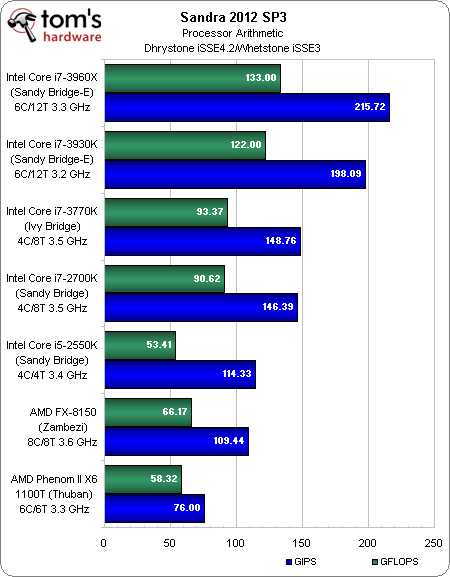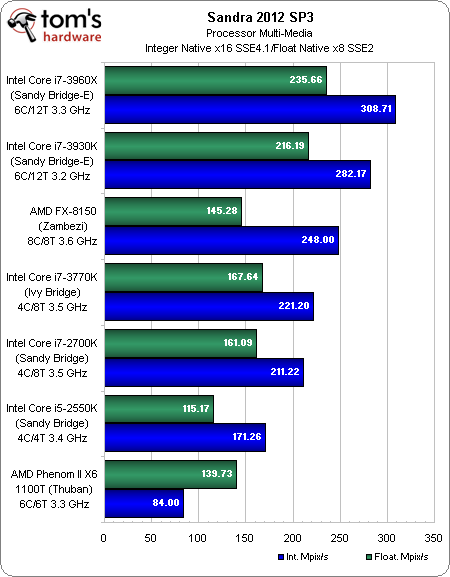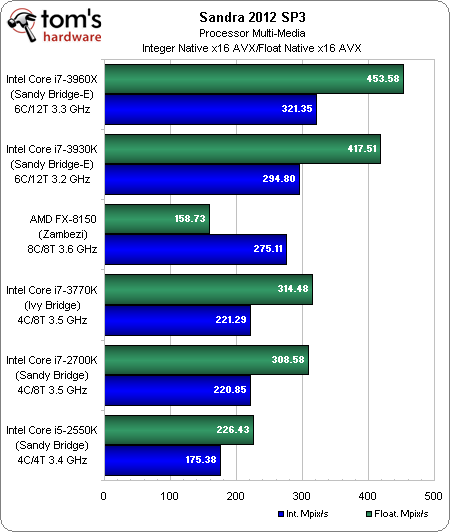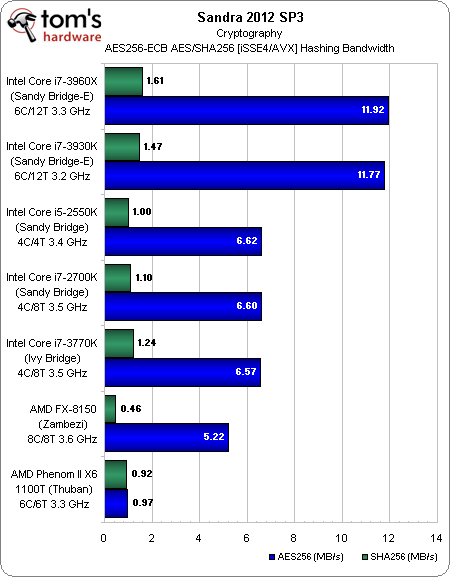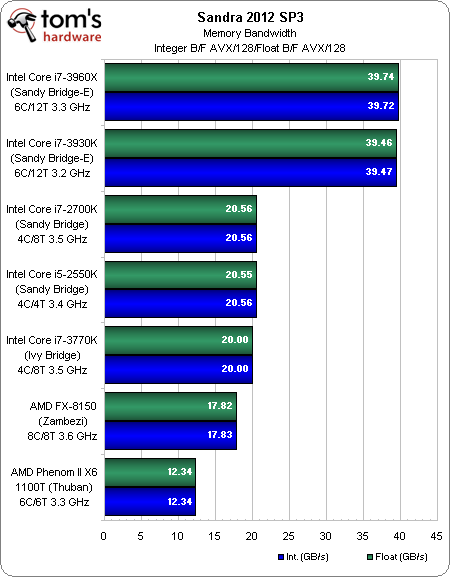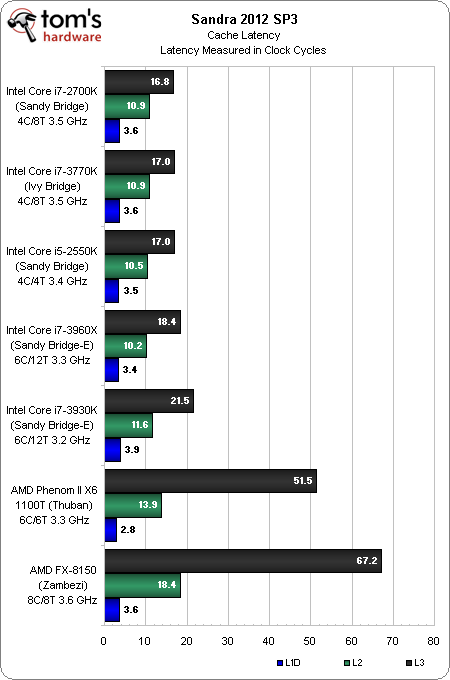Intel Core i7-3770K Review: A Small Step Up For Ivy Bridge
Benchmark Results: Sandra 2012 SP3
More so than PCMark or 3DMark, Sandra is good for extracting the potential performance from each of these CPUs.
Clearly, the six-core Sandy Bridge-E parts serve up the highest numbers in Sandra’s Arithmetic test. Ivy Bridge’s slight IPC improvements translate into a comparably slim advantage over Core i7-2700K, and both of those parts are substantially faster than the remaining three processors.
I broke out the multimedia results into two charts, since Phenom II doesn’t support AVX. Integer performance is a strong suit for AMD’s FX processor, which makes sense given its eight integer cores. Floating-point throughput isn’t as compelling. Again, that’s expected given the shared nature of the architecture’s resources devoted to floating-point math.
Leveraging AVX instructions, the eight-core FX is even able to outperform Intel’s Core i7-3770K in the integer component of this test. AMD is humbled by the floating-point portion, though, succumbing even to Intel’s Core i5-2550K. Its four modules (with four corresponding floating-point units) cannot keep up.
Ivy Bridge, meanwhile, is only marginally faster than Sandy Bridge at the same clock rate.
The clear winners here are the Core i7-3960X and 3930K, which brute-force the test using six cores.
Hardware support for AES encryption and decryption means that the Ivy Bridge, Sandy Bridge, and Bulldozer architectures can operate on data as fast as it’s delivered. Thus, the AES256 results scale according to memory bandwidth—the bottleneck in this equation. SHA hashing is a much slower process, which is dominated by the Sandy Bridge-E-based parts.
Get Tom's Hardware's best news and in-depth reviews, straight to your inbox.
And here are the bandwidth numbers to drive our Cryptography test results home. Operating at the same DDR3-1600 data rate, Ivy Bridge doesn’t demonstrate any advantage over Sandy Bridge, and in fact realizes slightly less overall throughput.
During the course of my review, SiSoftware issued Sandra 2012 SP4 based on discussions between Adrian Silasi and I about how the software addresses the clock rates of CPUs with dynamic frequency adjustment like Turbo Boost and Turbo Core.
Because I had all of my data compiled using SP3, though, I decided to use the older build, which reports results based on rated clocks, rather than actual clocks. And really, that decision was made based on the fact that Ivy Bridge and Sandy Bridge demonstrate nearly identical behavior, suggesting very similar cache latencies. Moving forward, I’ll swap over to SP4. But for now, the desired effect is achieved.
Current page: Benchmark Results: Sandra 2012 SP3
Prev Page Benchmark Results: 3DMark 11 Next Page Benchmark Results: Adobe CS 5.5-
tecmo34 Nice Review Chris...Reply
Looking forward to the further information coming out this week on Ivy Bridge, as I was initially planning on buying Ivy Bridge, but now I might turn to Sandy Bridge-E -
jaquith Great and long waited review - Thanks Chris!Reply
Temps as expected are high on the IB, but better than early ES which is very good.
Those with their SB or SB-E (K/X) should be feeling good about now ;) -
xtremexx saw this just pop up on google, posted 1 min ago, anyway im probably going to update i have a core i3 2100 so this is pretty good.Reply -
ojas it's heeearrree!!!!! lol i though intel wan't launching it, been scouring the web for an hour for some mention.Reply
Now, time to read the review. :D -
zanny It gets higher temps at lower frequencies? What the hell did Intel break?Reply
I really wish they would introduce a gaming platform between their stupidly overpriced x79esque server platform and the integrated graphics chips they are pushing mainstream. 50% more transistors should be 30% or so more performance or a much smaller chip, but gamers get nothing out of Ivy Bridge. -
JAYDEEJOHN It makes sense Intel is making this its quickest ramp ever, as they see ARM on the horizon in today's changing market.Reply
They're using their process to get to places they'll need to get to in the future -
verbalizer OK after reading most of the review and definitely studying the charts;Reply
I have a few things on my mind.
1.) AMD - C'mon and get it together, you need to do better...2.) imagine if Intel made an i7-2660K or something like the i5-2550K they have now.
3.) SB-E is not for gaming (too highly priced...) compared to i7 or i5 Sandy Bridge
4.) Ivy Bridge runs hot.......
5.) IB average 3.7% faster than i7 SB and only 16% over i5 SB = not worth it
6.) AMD - C'mon and get it together, you need to do better...
(moderator edit..) -
Pezcore27 Good review.Reply
To me it shows 2 main things. 1) that Ivy didn't improve on Sandy Bridge as much as Intel was hoping it would, and 2) just how far behind AMD actually is... -
tmk221 It's a shame that this chip is marginally faster than 2700k. I guess it's all AMD fault. there is simply no pressure on Intel. Otherwise they would already moved to 8, 6, and 4 cores processors. Especially now when they have 4 cores under 77W.Reply
Yea yea I know most apps won't use 8 cores, but that's only because there was no 8 cores processors in past, not the other way around
